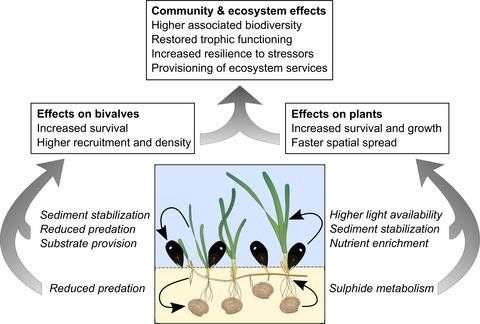当前位置:
X-MOL 学术
›
J. Appl. Ecol.
›
论文详情
Our official English website, www.x-mol.net, welcomes your feedback! (Note: you will need to create a separate account there.)
Facilitating foundation species: The potential for plant‐bivalve interactions to improve habitat restoration success
Journal of Applied Ecology ( IF 5.7 ) Pub Date : 2020-04-06 , DOI: 10.1111/1365-2664.13605 Karine Gagnon 1 , Eli Rinde 2 , Elizabeth G. T. Bengil 3, 4 , Laura Carugati 5 , Marjolijn J. A. Christianen 6, 7 , Roberto Danovaro 5, 8 , Cristina Gambi 5 , Laura L. Govers 7, 9 , Silvija Kipson 10 , Lukas Meysick 1 , Liina Pajusalu 11 , İnci Tüney Kızılkaya 3, 12 , Johan Koppel 9, 13 , Tjisse Heide 7, 9, 14 , Marieke M. Katwijk 7 , Christoffer Boström 1
Journal of Applied Ecology ( IF 5.7 ) Pub Date : 2020-04-06 , DOI: 10.1111/1365-2664.13605 Karine Gagnon 1 , Eli Rinde 2 , Elizabeth G. T. Bengil 3, 4 , Laura Carugati 5 , Marjolijn J. A. Christianen 6, 7 , Roberto Danovaro 5, 8 , Cristina Gambi 5 , Laura L. Govers 7, 9 , Silvija Kipson 10 , Lukas Meysick 1 , Liina Pajusalu 11 , İnci Tüney Kızılkaya 3, 12 , Johan Koppel 9, 13 , Tjisse Heide 7, 9, 14 , Marieke M. Katwijk 7 , Christoffer Boström 1
Affiliation

|
1. Vegetated marine and freshwater habitats are being increasingly lost around the world. Habitat restoration is a critical step for conserving these valuable habitats, but new approaches are needed to increase restoration success and ensure their survival.2. We investigated interactions between plants and bivalves through a review and analysis of 491 studies, determined the effects, mechanisms and key environmental variables involved in and driving positive and negative interactions, and produced guidelines for integrating positive interactions into restoration efforts in different habitats.3. Fifty per cent of all interactions (both correlative and experimental studies) were positive. These were predominant between epifaunal bivalves and plants in all habitats, and between infaunal bivalves and plants in subtidal habitats. Plants primarily promoted bivalve survival and abundance by providing substrate and shelter, while bivalves promoted plant growth and survival by stabilizing and fertilizing the sediment, and reducing water turbidity. The prevalence of positive interactions increased with water temperature in subtidal habitats, but decreased with water temperature in intertidal habitats. The subset of studies conducted in a restoration context also showed mostly positive interactions.4. Twenty‐five per cent of all interactions were negative, and these were predominant between plants and infaunal bivalves in intertidal habitats, except sulphide‐metabolizing bivalves, which facilitated plant survival. Interactions involving non‐native species were also mostly negative.5. Synthesis and applications. Promoting facilitative interactions through plant–bivalve co‐restoration can increase restoration success. The prevalence of positive interactions depends on habitat and environmental conditions such as temperature, and was especially important in subtidal habitats (involving both infaunal and epifaunal bivalves) and in intertidal habitats (involving only epifaunal bivalves). Thus sites and species for co‐restoration must be carefully chosen to maximize the chances of success. If done properly, co‐restoration could increase initial survival, persistence and resilience of foundation species, and promote the recovery of associated biodiversity and ecosystem services.
中文翻译:

促进基础物种:植物与双壳类动物相互作用的潜力,以提高栖息地恢复的成功率
1. 全世界越来越多的海洋和淡水植被栖息地正在消失。栖息地恢复是保护这些宝贵栖息地的关键步骤,但需要新的方法来提高恢复成功率并确保它们的生存。2.我们通过对 491 项研究的回顾和分析调查了植物和双壳类动物之间的相互作用,确定了影响和驱动正负相互作用的影响、机制和关键环境变量,并制定了将正相互作用纳入不同栖息地恢复工作的指南。 3.所有相互作用(相关研究和实验研究)中有 50% 是积极的。这些在所有栖息地的表生双壳类动物和植物之间以及潮下带栖息地的底栖动物双壳类动物和植物之间占主导地位。植物主要通过提供基质和庇护所来促进双壳类动物的生存和丰富,而双壳类动物则通过稳定和施肥沉积物以及降低水浊度来促进植物生长和存活。正相互作用的发生率随潮下带水温升高而增加,而在潮间带生境随水温升高而降低。在恢复环境中进行的研究子集也显示出大部分是积极的相互作用。4。所有相互作用中有 25% 是负面的,这些相互作用主要发生在潮间带栖息地的植物和底栖双壳类动物之间,但促进植物生存的硫化物代谢双壳类动物除外。涉及非本地物种的相互作用也大多是负面的。5。合成与应用。通过植物-双壳类共同恢复促进促进性相互作用可以提高恢复成功率。积极相互作用的普遍性取决于栖息地和环境条件,如温度,在潮下栖息地(包括内陆和外层双壳类动物)和潮间带栖息地(仅涉及外层双壳类动物)尤为重要。因此,必须仔细选择共同恢复的地点和物种,以最大限度地提高成功的机会。如果做得好,共同恢复可以提高基础物种的初始存活率、持久性和恢复力,并促进相关生物多样性和生态系统服务的恢复。并且在潮下栖息地(包括底栖和表层双壳类动物)和潮间带栖息地(仅涉及表底动物区系双壳类动物)中尤为重要。因此,必须仔细选择共同恢复的地点和物种,以最大限度地提高成功的机会。如果做得好,共同恢复可以提高基础物种的初始存活率、持久性和恢复力,并促进相关生物多样性和生态系统服务的恢复。并且在潮下栖息地(包括底栖和表层双壳类动物)和潮间带栖息地(仅涉及表底动物区系双壳类动物)中尤为重要。因此,必须仔细选择共同恢复的地点和物种,以最大限度地提高成功的机会。如果做得好,共同恢复可以提高基础物种的初始存活率、持久性和恢复力,并促进相关生物多样性和生态系统服务的恢复。
更新日期:2020-04-06
中文翻译:

促进基础物种:植物与双壳类动物相互作用的潜力,以提高栖息地恢复的成功率
1. 全世界越来越多的海洋和淡水植被栖息地正在消失。栖息地恢复是保护这些宝贵栖息地的关键步骤,但需要新的方法来提高恢复成功率并确保它们的生存。2.我们通过对 491 项研究的回顾和分析调查了植物和双壳类动物之间的相互作用,确定了影响和驱动正负相互作用的影响、机制和关键环境变量,并制定了将正相互作用纳入不同栖息地恢复工作的指南。 3.所有相互作用(相关研究和实验研究)中有 50% 是积极的。这些在所有栖息地的表生双壳类动物和植物之间以及潮下带栖息地的底栖动物双壳类动物和植物之间占主导地位。植物主要通过提供基质和庇护所来促进双壳类动物的生存和丰富,而双壳类动物则通过稳定和施肥沉积物以及降低水浊度来促进植物生长和存活。正相互作用的发生率随潮下带水温升高而增加,而在潮间带生境随水温升高而降低。在恢复环境中进行的研究子集也显示出大部分是积极的相互作用。4。所有相互作用中有 25% 是负面的,这些相互作用主要发生在潮间带栖息地的植物和底栖双壳类动物之间,但促进植物生存的硫化物代谢双壳类动物除外。涉及非本地物种的相互作用也大多是负面的。5。合成与应用。通过植物-双壳类共同恢复促进促进性相互作用可以提高恢复成功率。积极相互作用的普遍性取决于栖息地和环境条件,如温度,在潮下栖息地(包括内陆和外层双壳类动物)和潮间带栖息地(仅涉及外层双壳类动物)尤为重要。因此,必须仔细选择共同恢复的地点和物种,以最大限度地提高成功的机会。如果做得好,共同恢复可以提高基础物种的初始存活率、持久性和恢复力,并促进相关生物多样性和生态系统服务的恢复。并且在潮下栖息地(包括底栖和表层双壳类动物)和潮间带栖息地(仅涉及表底动物区系双壳类动物)中尤为重要。因此,必须仔细选择共同恢复的地点和物种,以最大限度地提高成功的机会。如果做得好,共同恢复可以提高基础物种的初始存活率、持久性和恢复力,并促进相关生物多样性和生态系统服务的恢复。并且在潮下栖息地(包括底栖和表层双壳类动物)和潮间带栖息地(仅涉及表底动物区系双壳类动物)中尤为重要。因此,必须仔细选择共同恢复的地点和物种,以最大限度地提高成功的机会。如果做得好,共同恢复可以提高基础物种的初始存活率、持久性和恢复力,并促进相关生物多样性和生态系统服务的恢复。


























 京公网安备 11010802027423号
京公网安备 11010802027423号